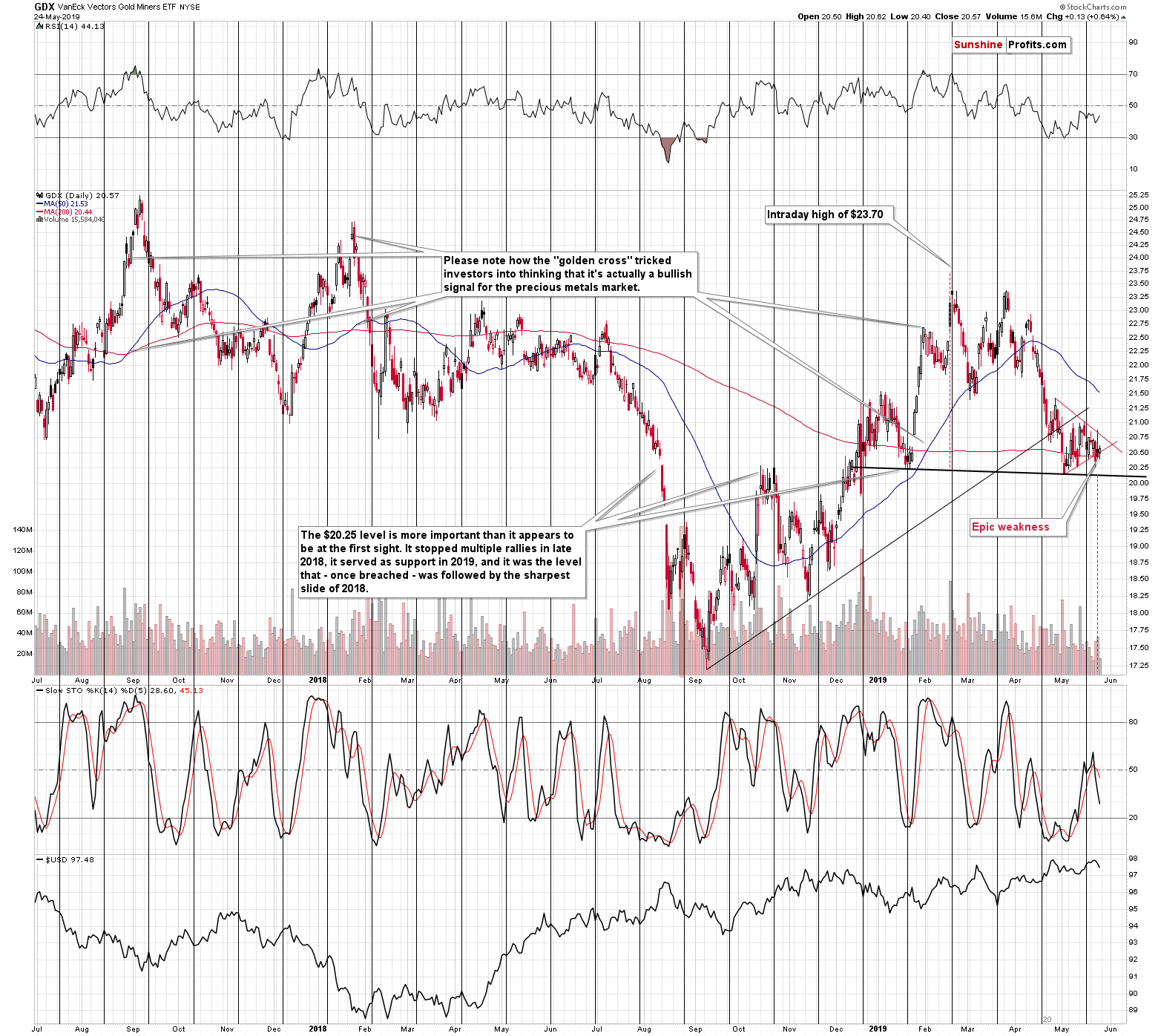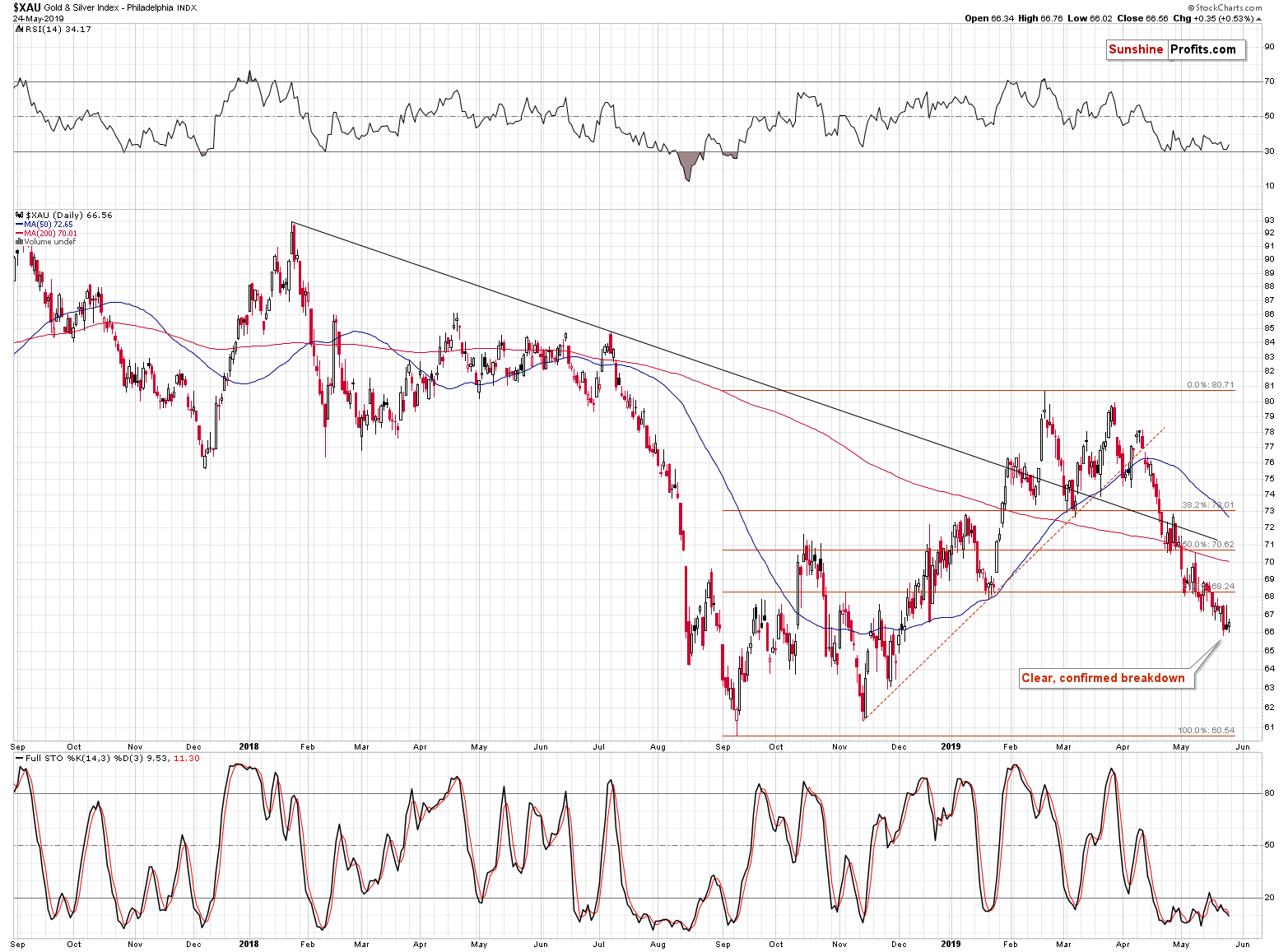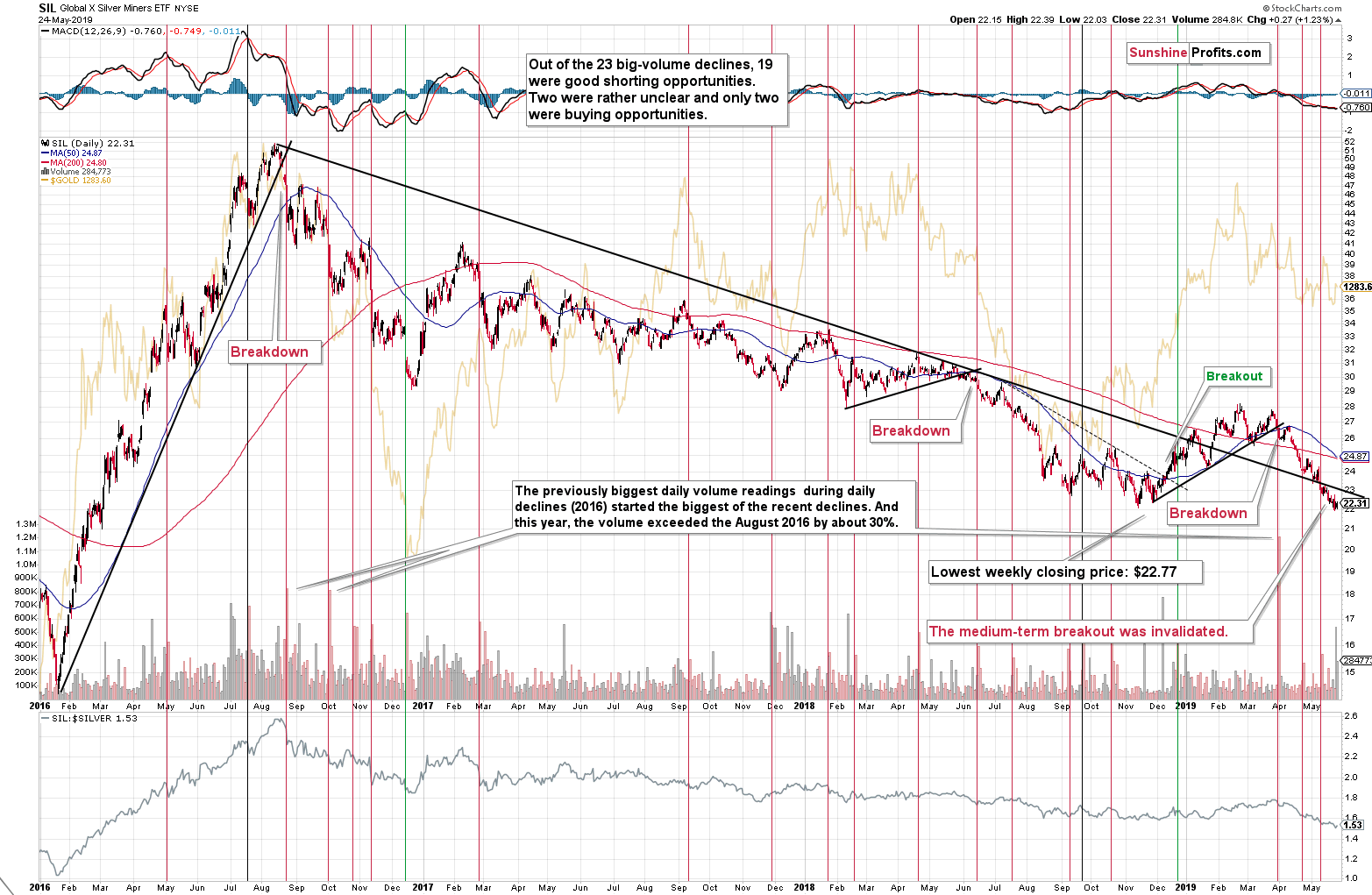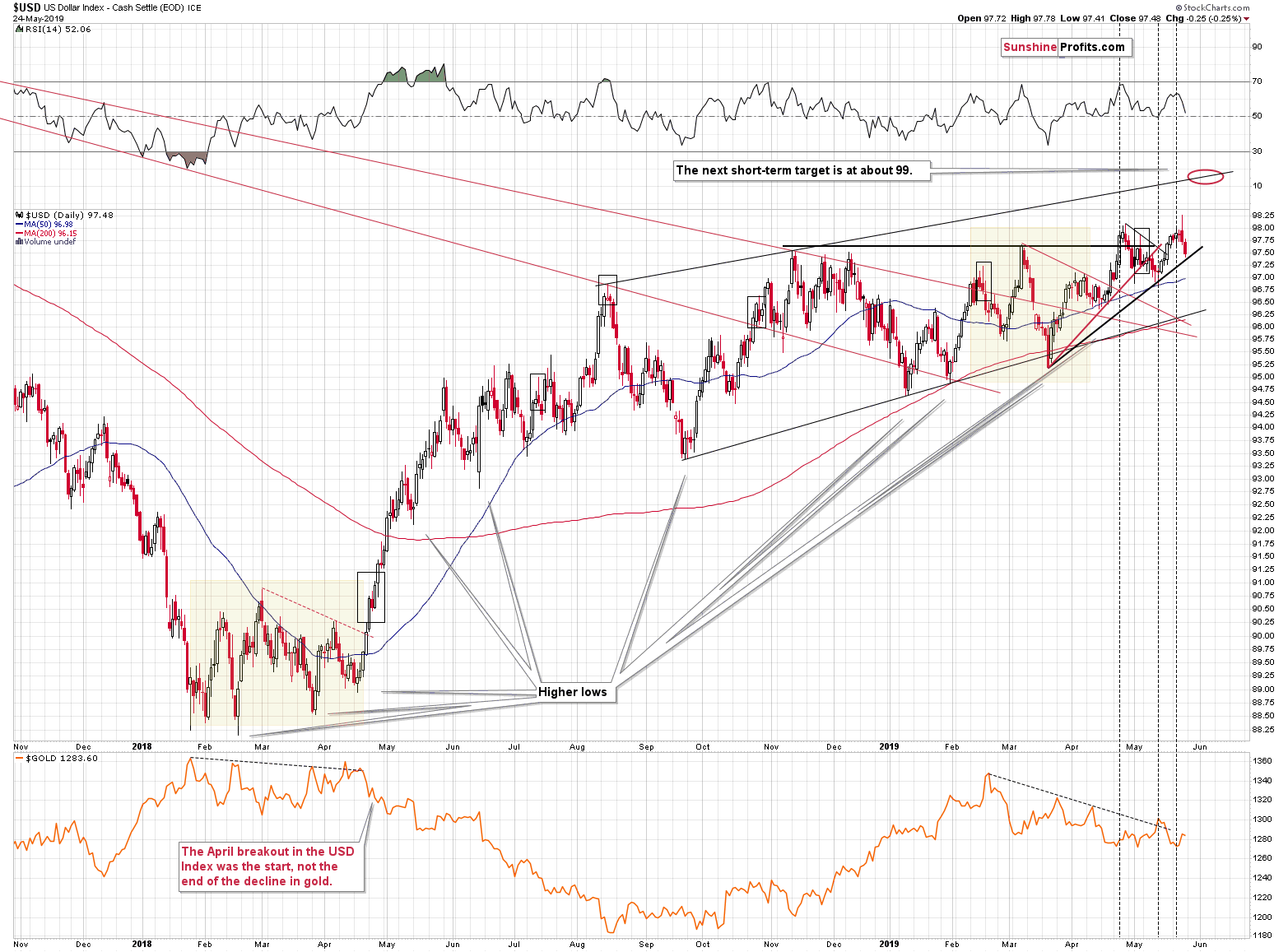Briefly: in our opinion, full (250% of the regular size of the position) speculative short position in gold, silver, and mining stocks is justified from the risk/reward perspective at the moment of publishing this Alert.
Friday was a quiet day in gold and silver, which is quite often the case right before long weekends. The USD Index, however, moved to the downside and this seems to have triggered some strength in the mining stocks. The miners didn't move far, but enough to come back to the previously broken triangle pattern. What does this invalidation mean for this week?
Let's take a closer look at what happened.
GDX and Looking Under the Hood of Other Miners
The GDX closed a few cents above the lower border of the triangle and it took place on low volume. One likely reason for the lower volume is that right before the long weekend, some traders wanted to end their work earlier or took time off entirely for the day to make their travel plans easier. Or it could have been the case that institutions had a policy that prevents them from keeping positions open over long weekends as markets might move sharply on the first day of trading after a longer pause (by the way, this is the reasons why we are closing the positions at 2 PM on Friday in our Day Trading Signals). This means that the move might have been accidental and that we should look for confirmations in other mining sector proxies.
Let's start with the HUI Index - the flagship proxy for gold stocks.
Gold miners moved up by just 0.49 and they closed the day and the week visibly below the January 2019 lows. The breakdown below these lows was confirmed, not invalidated. Consequently, the HUI Index doesn't agree with GDX's tiny invalidation.
Let's say it's a tie for now.
The XAU Index, the more universal proxy that takes into account both: gold stocks and silver stocks, definitely leans toward HUI's signal. The breakdown below the January lows has been confirmed several days ago and Friday's tiny move higher changed absolutely nothing.
What about the silver miners on their own?
The important thing that happened on Friday was actually a breakdown. The SIL ETF closed the week at $22.31, and the lowest weekly closing price of January 2019 was $22.77. The implications are breakdown in terms of weekly closing prices - that's bearish for the following weeks and the above-mentioned bearish implications are confirmed.
The silver miners recently moved higher on significant volume, but this action was previously accompanied by both: rallies, and downswings, so it's not a reliable indication. For instance, in mid-May 2017, such action confirmed a top, and in March 2016, it was followed by an upswing. All in all, the volume spike during a daily upswing doesn't change anything, whereas a daily volume spike would have bearish implications. That's what we saw three times in the last 2 months.
Before summarizing, let's take a look at the USD Index.
The USD Index: Downside Target Reached
In Friday's analysis, we wrote the following regarding Thursday's reversal:
The USD Index reversed in a clear way, which likely caught everyone's attention. No wonder that gold and silver investors reacted as well. But, let's check how often these reversals marked tops in the recent past and how often they were followed by some other price action. We marked similar cases with grey rectangles.
In April 2018 this kind of reversal formed early during a massive rally. [VERY BULLISH]
In August 2018 this kind of reversal formed at the top. [BEARISH]
In October 2018 this kind reversal formed within a rally - the final top was over 1 index point above the reversal's closing price. [BULLISH]
In February 2019 this kind of reversal formed at the top. [BEARISH]
In early May 2019 this kind of reversal formed close to local bottoms - higher prices followed relatively soon. [BULLISH]
So, we have 5 similar cases, 3 of which were actually bullish. So, should we really take the reversal as a bearish signal this time? What seems much more likely than a profound decline from here, is a tiny move lower to the rising black support line (about 0.3 below yesterday's closing price) and then another wave up. This action would be most similar to the most recent, early-May analogy. At the moment of writing these words, the USD Index is already down by 0.16 today and gold and silver are basically flat (precisely, gold is down $0.80 and silver is down $0.05) in turn.
In short, the above remains up-to-date. We wrote about the possible move of 0.3 below Thursday's closing price, and that's what we saw. The USD Index moved lower by 0.32 intraday and fininshed the day 0.25 lower.
This means that even though we saw a reversal on Thursday, the move higher might continue shortly.
Summary
Summing up, the quick rally in gold and silver is likely over or very close to being over. The GDX ETF invalidated the previous breakdown by a few cents, but other proxies for the mining stocks continue to paint a very bearish picture for the coming weeks. The epic weakness in the miners (gold was up last week, while miners were down) serves as yet another confirmation of the bearish outlook. The next big move lower appears to be just around the corner. The next reversal is likely to take place close to or at the turn of the month. This means that we are likely to see either a volatile move lower this week, or the start of the next sizable downswing might be delayed until the next week and start in early June. In other words, gold might reach our interim target level of $1,240 shortly and thus we might adjust our trading position also relatively soon.
To summarize:
Trading capital (supplementary part of the portfolio; our opinion): Full short position (250% of the full position) in gold, silver, and mining stocks is justified from the risk/reward perspective with the following stop-loss orders and exit profit-take price levels:
- Gold: profit-take exit price: $1,241; stop-loss: $1,357; initial target price for the DGLD ETN: $51.87; stop-loss for the DGLD ETN $39.87
- Silver: profit-take exit price: $13.81; stop-loss: $15.72; initial target price for the DSLV ETN: $39.38; stop-loss for the DSLV ETN $26.97
- Mining stocks (price levels for the GDX ETF): profit-take exit price: $17.61; stop-loss: $24.17; initial target price for the DUST ETF: $34.28; stop-loss for the DUST ETF $15.47
In case one wants to bet on junior mining stocks' prices (we do not suggest doing so - we think senior mining stocks are more predictable in the case of short-term trades - if one wants to do it anyway, we provide the details), here are the stop-loss details and target prices:
- GDXJ ETF: profit-take exit price: $24.71; stop-loss: $35.67
- JDST ETF: profit-take exit price: $78.21 stop-loss: $30.97
Long-term capital (core part of the portfolio; our opinion): No positions (in other words: cash)
Insurance capital (core part of the portfolio; our opinion): Full position
Whether you already subscribed or not, we encourage you to find out how to make the most of our alerts and read our replies to the most common alert-and-gold-trading-related-questions.
Please note that the in the trading section we describe the situation for the day that the alert is posted. In other words, it we are writing about a speculative position, it means that it is up-to-date on the day it was posted. We are also featuring the initial target prices, so that you can decide whether keeping a position on a given day is something that is in tune with your approach (some moves are too small for medium-term traders and some might appear too big for day-traders).
Plus, you might want to read why our stop-loss orders are usually relatively far from the current price.
Please note that a full position doesn't mean using all of the capital for a given trade. You will find details on our thoughts on gold portfolio structuring in the Key Insights section on our website.
As a reminder - "initial target price" means exactly that - an "initial" one, it's not a price level at which we suggest closing positions. If this becomes the case (like it did in the previous trade) we will refer to these levels as levels of exit orders (exactly as we've done previously). Stop-loss levels, however, are naturally not "initial", but something that, in our opinion, might be entered as an order.
Since it is impossible to synchronize target prices and stop-loss levels for all the ETFs and ETNs with the main markets that we provide these levels for (gold, silver and mining stocks - the GDX ETF), the stop-loss levels and target prices for other ETNs and ETF (among other: UGLD, DGLD, USLV, DSLV, NUGT, DUST, JNUG, JDST) are provided as supplementary, and not as "final". This means that if a stop-loss or a target level is reached for any of the "additional instruments" (DGLD for instance), but not for the "main instrument" (gold in this case), we will view positions in both gold and DGLD as still open and the stop-loss for DGLD would have to be moved lower. On the other hand, if gold moves to a stop-loss level but DGLD doesn't, then we will view both positions (in gold and DGLD) as closed. In other words, since it's not possible to be 100% certain that each related instrument moves to a given level when the underlying instrument does, we can't provide levels that would be binding. The levels that we do provide are our best estimate of the levels that will correspond to the levels in the underlying assets, but it will be the underlying assets that one will need to focus on regarding the signs pointing to closing a given position or keeping it open. We might adjust the levels in the "additional instruments" without adjusting the levels in the "main instruments", which will simply mean that we have improved our estimation of these levels, not that we changed our outlook on the markets. We are already working on a tool that would update these levels on a daily basis for the most popular ETFs, ETNs and individual mining stocks.
Our preferred ways to invest in and to trade gold along with the reasoning can be found in the how to buy gold section. Additionally, our preferred ETFs and ETNs can be found in our Gold & Silver ETF Ranking.
As a reminder, Gold & Silver Trading Alerts are posted before or on each trading day (we usually post them before the opening bell, but we don't promise doing that each day). If there's anything urgent, we will send you an additional small alert before posting the main one.
=====
Latest Free Trading Alerts:
We have said the bulls had a bad day on Wednesday. How would you rate their yesterday's performance? Heck, they are not having a good day today either. Black gold is heading for the biggest weekly loss in 2019. Has the support fallen out from below? Where can we expect the decline to stop?
Oil Bulls, Are You Serious About Arresting the Slide?
=====
Thank you.
Sincerely,
Przemyslaw Radomski, CFA
Editor-in-chief, Gold & Silver Fund Manager








